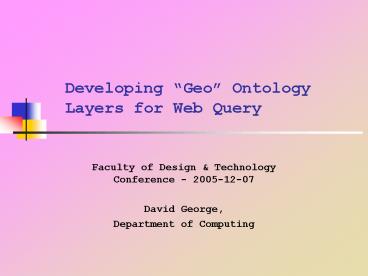Developing Geo Ontology Layers for Web Query PowerPoint PPT Presentation
1 / 30
Title: Developing Geo Ontology Layers for Web Query
1
Developing Geo Ontology Layers for Web Query
- Faculty of Design Technology Conference -
2005-12-07 - David George,
- Department of Computing
2
Key Considerations of this Presentation
- The Web The Global Information Space
- Previous data and information integration
approaches. - What is an Ontology?
- Semantic Web and Ontology - as method of linking
(or integrating) data, information and knowledge. - Research direction Geographical Ontology Layers
for Application-based Query.
3
The Web a Global Information Space
- Graphical representation of World Wide Web around
Google - (from Wikipedia, a Web-based free-content
encyclopaedia)
4
Efficient Web Querying?
5
Efficient Web Querying?
- Google query for Cook
- results - 130,000,000 English pages
- Google New Zealand
- results - 230,000,000 pages
- Cook New Zealand
- results 38,600,000
- Cook discovered New Zealand
- 950,000
- Cook discovered New Zealand
- 167 English pages
6
Historical Integration Approaches
7
Historical Characteristics
- Data and information repositories pre-exist and
invariably heterogeneous in - Syntax
- Structure
- Semantics
- Integration or mappings are effected
after-the-event. - Increasing us of intelligent agents
8
Ontologies what are they?
- In Computing - ontology is a formal vocabulary of
a universe of discourse e.g. medicine,
geography, ... - An Ontology defines
- concepts and their attributes.
- relationships between concepts.
- constraints on those relationships.
An Ontology is a formal, explicit specification
of a shared conceptualisation (Gruber, 1993
Borst, 1997)
9
Geographical Ontology (extract)
10
Semantic Web Characteristics
- Its not here yet! Limited examples of
implementation e.g. RSS News feeds. - Focus on mappings of data sources to existing
resources, e.g. generic, domain and
application-based ontology structures - Existing Web data will require monumental
conversion or exist in parallel. - Particular relevance in Scientific, Academic,
Defence, and Commercial enterprises. - Specialised tools required.
11
Semantics on the Web
- Cook discovered New Zealand.
- "Robin Cook" discovered "New Zealand
- 12,000 English pages !!!!
- Semantic Web solution?
- RDF and OWL Ontology technologies
- RDF triple (s,p,o) - based on a binary directed
relationship. - Using predicate discovered e.g.
- discovered(Cook, New Zealand)
12
Semantic Web Page
- RDF is a graph-based model for describing how
Internet resources relate to each other (e.g. Web
pages, email messages, RSS, searches). - RDF provides a model for metadata, i.e. a
mechanism for integrating and organising those
resources. - RDF/XML is a serialization syntax that allows the
graph-based model to be communicated between
"agents".
13
WWW and Semantic Web
14
Graduate School Scenario
15
RDF Example linked resources
RDF/XML Serialisation lt?xml version"1.0"
encoding"iso-8859-1"?gt ltrdfRDF
xmlnsrdf"http//www.w3.org/1999/02/22-rdf-syntax
-ns" xmlnsinfo"http//www.dgeorge.
com/vocabulary/pim/info"gt ltinfoPerson
rdfabout"http//www.uclan.ac.uk/gradschool/conf/
dec05/index.htmDGeorge"gt ltinfofullNamegtDavid
Georgelt/infofullNamegt ltinfomailbox
rdfresource"mailtodgeorge_at_uclan.ac.uk"/gt
ltinfoactivitygtResearch Studentlt/infoactivitygt
ltinfopresentation rdfresource"http//www.ucla
n.ac.uk/gradschool/conf/dec05/George-D-ppt.htm"/gt
lt/infoPersongt lt/rdfRDFgt
16
Geographic Ontology Layers
17
Geographic Ontology Layers
18
Road Transportation Populations
19
Road Transportation Populations
20
Road Transportation Populations
OWL Ontology Language
21
Linked Ontology Layers
22
(No Transcript)
23
(No Transcript)
24
(No Transcript)
25
(No Transcript)
26
Bibliographic Data Ontology (extract)
27
XML and RDF
- XML allows you to invent tags (extensibility)
that can contain both text data and other tags - ltDescriptiongtThe value of this property contains
some text, mixed up with child properties such as
its temperature (ltTempgt48lt/Tempgt) and longitude
(ltLonggt101lt/Longgt). lt/Descriptiongt - XML documents can present weird data structures
that mix trees, graphs, and character strings. In
general, these are hard to handle in even
moderate amounts. - XML is a vital part of the solution to RDF's
Interchange design goal as XML is unequalled as
an exchange format on the Web. - But by itself, it doesn't provide what you need
in a metadata framework.
28
XML and RDF
- RDF is a framework for describing and
interchanging metadata, built on these rules - A Resource is anything that can have a URI this
includes all the Web's pages, as well as
individual elements of an XML document. - A Property is a Resource that has a name and can
be used as a property, for example Author or
Title. - A Statement consists of the combination of a
Resource, a Property, and a value ('subject',
'predicate' and 'object). E.g. "The Author of
http//www.textuality.com/RDF/Why.html is Tim
Bray." The value can just be a string, for
example "Tim Bray, or another resource,
http//www.textuality.com/RDF/author.htmlTimBray - The RDF would be expressed in XML, e.g.
- ltrdfDescription about'http//www.textuality.com/
RDF/Why-RDF.html'gt ltAuthorgtTim Braylt/Authorgt
ltHome-Page rdfresource'http//www.textuality.com
' /gt lt/rdfDescriptiongt
29
XML Page has author Sid
- ltauthorgt
- lturigtpagelt/urigt
- ltnamegtSidlt/namegt
- lt/authorgt
- or
- ltdocument href"page"gt
- ltauthorgtSidlt/authorgt
- lt/documentgt
- or
- ltdocumentgt
- ltdetailsgt
- lturigthref"page"lt/urigt
- ltauthorgt
- ltnamegtSidlt/namegt
- lt/authorgt
- lt/detailsgt
- lt/documentgt
30
XML Page has author Sid
- ltvgt
- ltxgt
- ltygt a"ppppp"lt/ygt
- ltzgt
- ltwgtqqqqqlt/wgt
- lt/zgt
- lt/xgt
- lt/vgt
- It can not be determined whether ppp is a y of
qqq, or qqq is a z of ppp, or what. - ltrdfDescription about'http//www.textuality.com/
RDF/Why-RDF.html'gt ltAuthorgtTim Braylt/Authorgt - ltHomepage rdfresource'http//www.textuality.com'
/gt - lt/rdfDescriptiongt
- Consider that the RDF "description" element
indicates to the parser how to find the subjects
and objects that follow.

